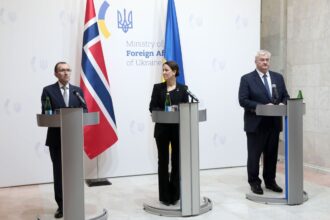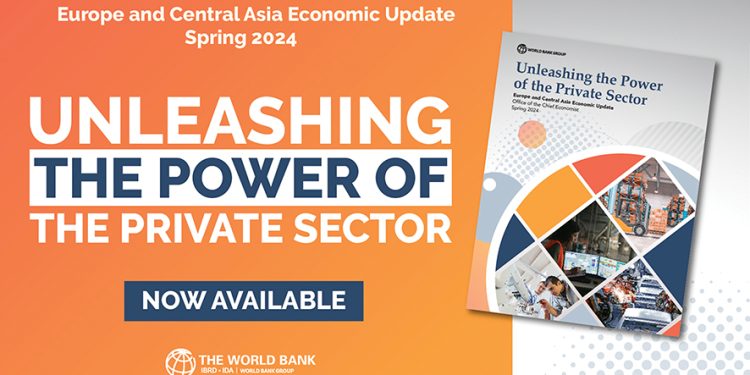The World Bank’s Economic update for the region released today predicts that economic activity in emerging and developing economies in Europe and Central Asia will slow down this year due to a weaker global market, tighter monetary policy, a slowdown in China, and lower commodity prices.
The regional growth rate is expected to slow down to 2.8% in this year after a substantial increase to 3.3% in the previous year. This was due to the return to growth of both Russia and the war-torn Ukraine’s economies, as well as a more robust recovery of Central Asia. In 2025, the regional output growth is expected to remain largely unchanged.
Multiple factors are affecting the outlook. Growth could be further dampened by a slower-than-expected economic recovery in key trading partners. This is especially true in the euro zone.
“Countries in Europe and Central Asia continue facing multiple crises, which are exacerbated by the challenging global growth environment,” said Antonella Basani, World Bank Vice-President for Europe and Central Asia. “Reviving the productivity growth through business dynamism, and improving resilience to the risks of climate change, can help protect and accelerate the economic growth in the region.”
The slow growth of the region will delay the recovery from recent shocks such as the ongoing Russian invasion of Ukraine, the pandemic and the 2022 cost of living crisis.
In the emerging markets and developing countries (EMDEs), mainly in Europe and Central Asia due to the steep declines in energy and food prices worldwide, inflation has fallen faster than anticipated. Inflation in the region dropped from 15% to 4.2% per annum by February 2024, a drop of over half. The 2022 cost of living crisis continues to affect household despite increases in incomes last year.
The pace of recovery in Ukraine is expected to slow down to 3.2% from 4.8% by 2023. This is due to a smaller harvest as well as a persistent labor shortage. The economic outlook of the country is still dependent on donor support, and the duration that Russia will continue to invade. According to recent estimates from the World Bank and other institutions, the cost of rebuilding and recovering in Ukraine has risen to $486 billion. This is more than twice the size of Ukraine’s pre-war economic output in 2021.
Turkiye’s growth is also expected to slow to 3% in this year, its lowest level since 2009 (except for the pandemic years) as macroeconomic consolidation will likely restrain domestic demand. Global oil prices are expected to dampen prospects in Central Asia. Growth will slow from 5.5% estimated for 2023 to 4.1% this coming year.
The growth in the South Caucasus will slow from 3.8 percent to 3.5 percent by 2024 as key trading partners such as the European Union experience a slower pace of growth.
In a video, Roland Price, Regional Director of the World Bank for the South Caucasus, stated that “this backdrop is expected to lead to an economic growth in Georgia of 5.2 percent by 2024, which will remain above the regional average.” “Despite a slowdown of money transfer inflows and robust investment, it is expected that tourism will continue to support growth. Inflation is expected by end-2024 to reach its target of 3 percent, while monetary policies will continue to be eased gradually.
“The report includes a special chapter on unleashing power of the private sectors. It states that the economic development of the region has been a tale of transition from planned economies to market economies and that the emergence and growth of private initiative have been the main drivers of prosperity and growth.
“While Georgia has successfully completed first-generation market reforms, the path to EU accession brings unique opportunities to strengthen institutions and regulatory enforcement as well as boost integration into international marketplaces.
Price concluded that “for Georgia, as well as other countries in the area, boosting the business dynamism requires addressing several challenges. These include upgrading the competition climate, reducing the state involvement in the economic, improving the education quality, and strengthening the available finance for firms.”
In less than 30 years, 12 countries from the region have joined the European Union. The transformation of these countries into EU-integrated markets with robust institutions and production structure illustrates the success achieved by some of these countries, who have also reached high-income status.
Ivailo Izvorski is the World Bank’s Chief Economist in Europe and Central Asia. He said that private sector companies in many countries in this region face barriers which hinder their ability to expand and innovate. “To boost business dynamism, we will need to address several challenges, such as upgrading the competition climate, reducing the state’s involvement in the economy and improving the quality of the education.
To promote competition and free markets, efforts should be focused on reducing entry barriers and facilitating exit for unproductive companies. The presence of large state-owned companies is a major obstacle to leveling the playing field between private and public enterprises.
Private companies are also confronted with a workforce that is not adequately educated and large skill gaps, which are major obstacles to growth. In the short-term, high emigration rates among young and skilled workers are not helpful. A more educated workforce can lead to higher productivity and innovation.
The amount of bank lending to the private industry is low and hasn’t increased in the last decade. Lending tends to be shorter-term. Long-term financing is needed to improve productivity and innovation.
Read More @ georgiatoday.ge




